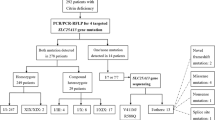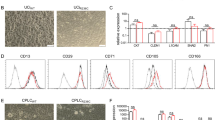Abstract
Lysinuric protein intolerance (LPI) is a rare autosomal inherited disease caused by defective cationic aminoacid transport 4F2hc/y+LAT-1 at the basolateral membrane of epithelial cells in the intestine and kidney. LPI is a multisystemic disease with a variety of clinical symptoms such as hepatosplenomegaly, osteoporosis, hypotonia, developmental delay, pulmonary insufficiency or end-stage renal disease. The SLC7A7 gene, which encodes the y+LAT-1 protein, is mutated in LPI patients. Mutation analysis of the promoter localized in intron 1 and all exons of the SLC7A7 gene was performed in 11 patients from 9 unrelated LPI families. Point mutation screening was performed by exon direct sequencing and a new multiplex ligation probe amplification (MLPA) assay was set up for large rearrangement analysis. Eleven SLC7A7-specific mutations were identified, seven of them were novel: p.L124P, p.C425R, p.R468X, p.Y274fsX21, c.625+1G>C, DelE4-E11 and DelE6-E11. The novel large deletions originated by the recombination of Alu repeats at introns 3 and 5, respectively, with the same AluY sequence localized at the SLC7A7 3′ region. The novel MLPA assay is robust and valuable for LPI molecular diagnosis. Our results suggest that genomic rearrangements of SLC7A7 play a more important role in LPI than has been reported, increasing the detection rate from 5.1 to 21.4%. Moreover, the 3′ region AluY repeat could be a recombination hot spot as it is involved in 38% of all SLC7A7 rearranged chromosomes described so far.
Similar content being viewed by others
Log in or create a free account to read this content
Gain free access to this article, as well as selected content from this journal and more on nature.com
or
References
Simell O : Lysinuric protein intolerance and other cationic aminoacidurias; in Scriver CR, Beaudet AL, Sly WS, Valle D (eds): The Metabolic and Molecular Bases of Inherited Disease. New York, McGraw-Hill, 2001, Vol III, pp 4933–4956.
Mykkanen J, Torrents D, Pineda M et al: Functional analysis of novel mutations in y(+)LAT-1 amino acid transporter gene causing lysinuric protein intolerance (LPI). Hum Mol Genet 2000; 9: 431–438.
Sperandeo MP, Bassi MT, Riboni M et al: Structure of the SLC7A7 gene and mutational analysis of patients affected by lysinuric protein intolerance. Am J Hum Genet 2000; 66: 92–99.
Noguchi A, Shoji Y, Koizumi A et al: SLC7A7 genomic structure and novel variants in three Japanese lysinuric protein intolerance families. Hum Mutat 2000; 15: 367–372.
Cimbalistiene L, Lehnert W, Huoponen K, Kucinskas V : First reported case of lysinuric protein intolerance (LPI) in Lithuania, confirmed biochemically and by DNA analysis. J Appl Genet 2007; 48: 277–280.
Sperandeo MP, Andria G, Sebastio G : Lysinuric protein intolerance: update and extended mutation analysis of the SLC7A7 gene. Hum Mutat 2008; 29: 14–21.
Palacín M, Nunes V, Font-Llitjós M et al: The genetics of heteromeric amino acid transporters. Physiology (Bethesda) 2005; 20: 112–124.
Tanner LM, Nanto-Salonen K, Niinikoski H et al: Nephropathy advancing to end-stage renal disease: a novel complication of lysinuric protein intolerance. J Pediatr 2007; 150: 631–634, 634.e1.
Palacin M, Bertran J, Chillaron J, Estevez R, Zorzano A : Lysinuric protein intolerance: mechanisms of pathophysiology. Mol Genet Metab 2004; 81 (Suppl 1): S27–S37.
Broer S : Lysinuric protein intolerance: one gene – many problems. Am J Physiol Cell Physiol 2007; 293: C540–C541.
Tanner LM, Nanto-Salonen K, Niinikoski H, Huoponen K, Simell O : Long-term oral lysine supplementation in lysinuric protein intolerance. Metabolism 2007; 56: 185–189.
Lauteala T, Mykkanen J, Sperandeo MP et al: Genetic homogeneity of lysinuric protein intolerance. Eur J Hum Genet 1998; 6: 612–615.
Lauteala T, Sistonen P, Savontaus ML et al: Lysinuric protein intolerance (LPI) gene maps to the long arm of chromosome 14. Am J Hum Genet 1997; 60: 1479–1486.
Torrents D, Mykkanen J, Pineda M et al: Identification of SLC7A7, encoding y+LAT-1, as the lysinuric protein intolerance gene. Nat Genet 1999; 21: 293–296.
Borsani G, Bassi MT, Sperandeo MP et al: SLC7A7, encoding a putative permease-related protein, is mutated in patients with lysinuric protein intolerance. Nat Genet 1999; 21: 297–301.
Puomila K, Simell O, Huoponen K, Mykkanen J : Two alternative promoters regulate the expression of lysinuric protein intolerance gene SLC7A7. Mol Genet Metab 2007; 90: 298–306.
Torrents D, Estévez R, Pineda M et al: Identification and characterization of a membrane protein (y+L amino acid transporter-1) that associates with 4F2hc to encode the amino acid transport activity y+L. A candidate gene for lysinuric protein intolerance. J Biol Chem 1998; 273: 32437–32445.
Palacín M, Borsani G, Sebastio G : The molecular bases of cystinuria and lysinuric protein intolerance. Curr Opin Genet Dev 2001; 11: 328–335.
Kent WJ : BLAT – the BLAST-like alignment tool. Genome Res 2002; 12: 656–664.
Schouten JP, McElgunn CJ, Waaijer R, Zwijnenburg D, Diepvens F, Pals G : Relative quantification of 40 nucleic acid sequences by multiplex ligation-dependent probe amplification. Nucleic Acids Res 2002; 30: e57.
Slater HR, Bruno DL, Ren H, Pertile M, Schouten JP, Choo KH : Rapid, high throughput prenatal detection of aneuploidy using a novel quantitative method (MLPA). J Med Genet 2003; 40: 907–912.
Gomez L, Garcia-Cazorla A, Gutierrez A et al: Treatment of severe osteoporosis with alendronate in a patient with lysinuric protein intolerance. J Inherit Metab Dis 2006; 29: 687.
Tsumura H, Suzuki N, Saito H et al: The targeted disruption of the CD98 gene results in embryonic lethality. Biochem Biophys Res Commun 2003; 308: 847–851.
Fort J, de la Ballina LR, Burghardt HE et al: The structure of human 4F2hc ectodomain provides a model for homodimerization and electrostatic interaction with plasma membrane. J Biol Chem 2007; 282: 31444–31452.
Proft M, Mas G, de Nadal E et al: The stress-activated Hog1 kinase is a selective transcriptional elongation factor for genes responding to osmotic stress. Mol Cell 2006; 23: 241–250.
Maquat LE, Carmichael GG : Quality control of mRNA function. Cell 2001; 104: 173–176.
Reig N, del Rio C, Casagrande F et al: Functional and structural characterization of the first prokaryotic member of the L-amino acid transporter (LAT) family: a model for APC transporters. J Biol Chem 2007; 282: 13270–13281.
Stiburek L, Fornuskova D, Wenchich L, Pejznochova M, Hansikova H, Zeman J : Knockdown of human Oxa1l Impairs the biogenesis of F(1)F(o)-ATP synthase and NADH:Ubiquinone oxidoreductase. J Mol Biol 2007; 374: 506–516.
Purandare SM, Patel PI : Recombination hot spots and human disease. Genome Res 1997; 7: 773–786.
Kolomietz E, Meyn MS, Pandita A, Squire JA : The role of Alu repeat clusters as mediators of recurrent chromosomal aberrations in tumors. Genes Chromosomes Cancer 2002; 35: 97–112.
Kanno J, Hutchin T, Kamada F et al: Genomic deletion within GLDC is a major cause of non-ketotic hyperglycinaemia. J Med Genet 2007; 44: e69.
Baysal BE, Willett-Brozick JE, Filho PA, Lawrence EC, Myers EN, Ferrell RE : An Alu-mediated partial SDHC deletion causes familial and sporadic paraganglioma. J Med Genet 2004; 41: 703–709.
Bacolla A, Jaworski A, Larson JE et al: Breakpoints of gross deletions coincide with non-B DNA conformations. Proc Natl Acad Sci USA 2004; 101: 14162–14167.
Acknowledgements
We thank Helena Kruyer for editorial help. The samples and clinical information were kindly provided by Dr Lambruschini, Hospital General de Granollers, Spain; Dr Gómez and Dr Vilaseca, Hospital Sant Joan de Déu de Barcelona, Spain; Dr Gutiérrez Junquera and Dr Vilaseca, Complejo Hospitalario Universitario de Albacete, Spain; Dr Peña Quintana, Hospital Universitario Materno-Infantil de Canarias, Spain; Dr Antonio Baldellou, Hospital Infantil Miguel Servet de Zaragoza, Spain; Dr Quitral Cuevas, Valparaíso, Chile; Dr Vianey-Saban, Hôpital de Lyon, France; Drs Michelakakis and Xaidara, Institute of Child Health and University of Athens, Greece. This work was supported by the MEC (BFU2006-14600-C02-01/02/BMC and SAF2003-08940-01/02), EU (EUGINDAT; LSHM-CT-2003-502852) and the Generalitat de Catalunya (2006 SGR00018 and 2005 SGR00947).
Author information
Authors and Affiliations
Corresponding authors
Additional information
Supplementary Information accompanies the paper on European Journal of Human Genetics website (http://www.nature.com/ejhg)
Supplementary information
Rights and permissions
About this article
Cite this article
Font-Llitjós, M., Rodríguez-Santiago, B., Espino, M. et al. Novel SLC7A7 large rearrangements in lysinuric protein intolerance patients involving the same AluY repeat. Eur J Hum Genet 17, 71–79 (2009). https://doi.org/10.1038/ejhg.2008.145
Received:
Revised:
Accepted:
Published:
Issue date:
DOI: https://doi.org/10.1038/ejhg.2008.145
Keywords
This article is cited by
-
CUGC for lysinuric protein intolerance (LPI)
European Journal of Human Genetics (2020)
-
Overview of symptoms and treatment for lysinuric protein intolerance
Journal of Human Genetics (2019)
-
Recent progress of porcine milk components and mammary gland function
Journal of Animal Science and Biotechnology (2018)
-
Update on Lysinuric Protein Intolerance, a Multi-faceted Disease Retrospective cohort analysis from birth to adulthood
Orphanet Journal of Rare Diseases (2017)



